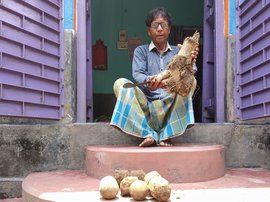It’s a hot and quiet February afternoon at the Rajaram Sugar Factory in Kolhapur district. The hundreds of khopyas (thatched huts of sugarcane workers) located on the premises of the factory are mostly empty. Migrant workers are cutting cane near Vadanage village, an hour's walk from here.
The distant sound of metal utensils being moved signals that some workers could be home. Following the sound leads us to 12-year-old Swati Maharnor who is getting ready to make her family’s dinner. Pale and exhausted we find her seated on the threshold of her family’s hut, all alone. Cooking utensils lie around her.
“I have been up since 3 a.m. in the morning,” she says, stifling a yawn.
The little girl left early this morning in a bullock cart with her parents, younger brother and grandfather to help cut sugarcane in Bavda taluka of Maharashtra. The family of five have been paid to cut 25 moli (bundles) a day, and all hands must help reach this target. They have packed bhakri and a brinjal sabji cooked the previous night for their lunch.
Only Swati returned at 1 p.m., walking back six kilometres to their home on the factory premises. “ Baba [grandfather] went back after dropping me.” She has come home earlier than the others to prepare dinner for the rest of the family who will return soon, hungry and tired from over 15 hours cutting cane. “We [the family] have had only a cup of tea since morning,” says Swati.
This daily up and down between the fields and her home, cutting cane and cooking, has been Swati’s routine for the last five months – ever since her family migrated to Kolhapur district from their home in Sakundwadi village in Beed district, in November 2022. They live here, spread across the factory's premises. A 2020 report brought out by Oxfam, Human Cost of Sugar said that migrant workers in Maharashtra often live in large colonies of makeshift tents with tarpaulin covers. The colonies are often without water, electricity or toilets.
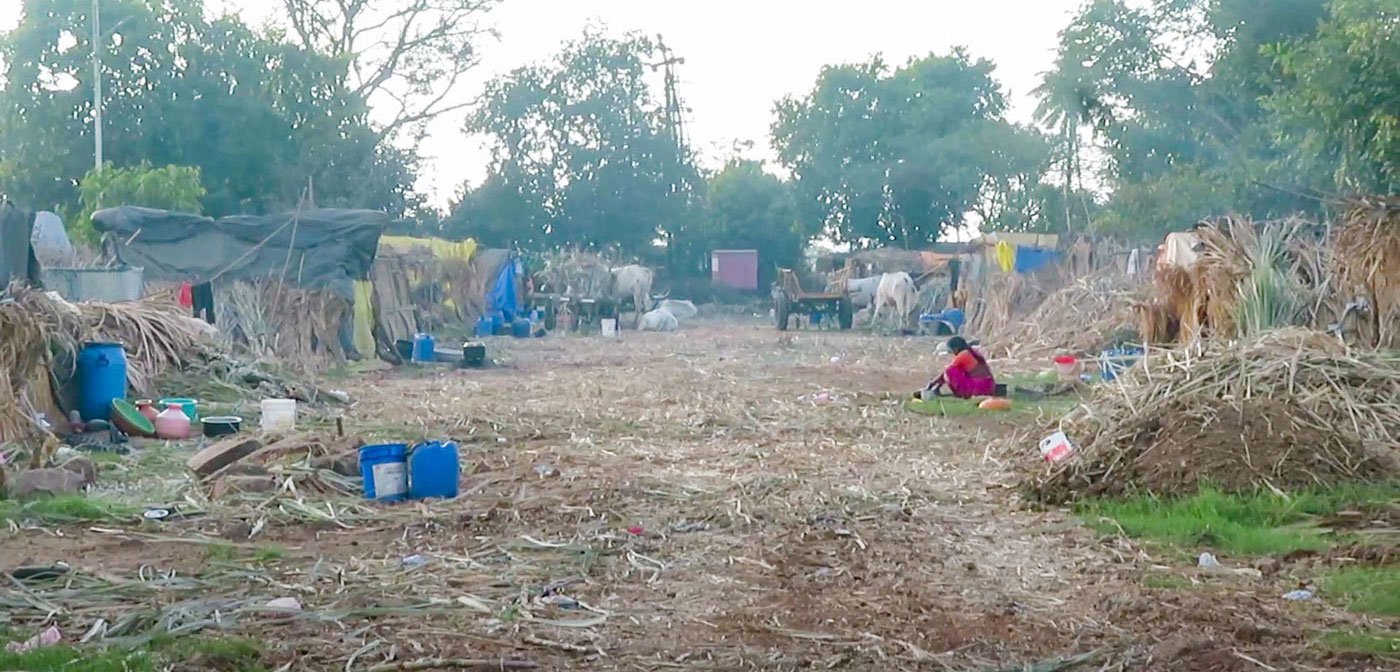
Khopyas (thatched huts) of migrant sugarcane workers of Rajaram Sugar Factory in Kolhapur district
“I don’t like cutting sugarcane,” says Swati. “I like to be in my village because I go to school there.” She is a student of Class 7 in the zilla parishad middle school back home in Sakundwadi village in Patoda taluk a. Krishna, her younger brother, studies in Class 3 in the same school.
Like Swati’s parents and grandfather, around 500 migrant workers are on contract to work at the Rajaram Sugar Factory during the sugarcane harvesting season. With them are their young children. “In March [2022], we were in Sangli,” says Swati. Both she and Krishna remain out-of-school for close to five months in a year.
“ Baba [grandfather] takes us back to our village every March so that we can attend our exams. We come back soon after to help our parents,” says Swati explaining how she and her brother manage to stay enrolled in the state school.
Being absent from school from November to March makes it difficult to clear the final exams. “We fare okay in subjects like Marathi and History, but Mathematics is difficult to understand,” Swati says. Some of her friends back home try to help, but it doesn’t make up for missed classes.
“What can be done? My parents need to work,” says Swati.
During the months when they do not migrate (June-October), Swati’s parents, Varsha, 35 and Bhausaheb, 45, work as agricultural labourers in the fields around Sakundwadi. “During monsoon season till kapani [harvesting], we get work in the fields back home for 4-5 days in a week,” says Varsha.
The family belongs to the Dhangar community, listed as a Nomadic Tribe in Maharashtra. The couple earns Rs. 350 a day – Varsha earns Rs. 150 and Bhausaheb Rs. 200. When work dries up near their village, they migrate out to seek work as cane cutters.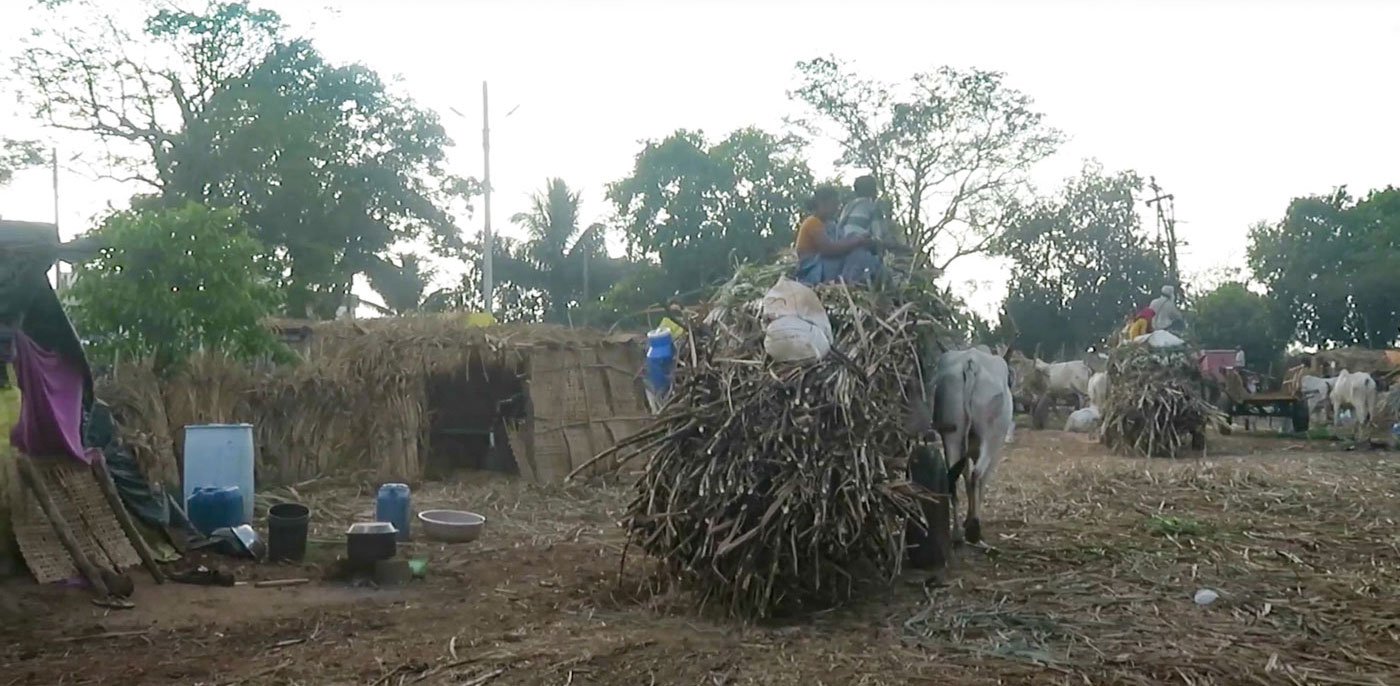
Sugarcane workers transporting harvested sugarcane in a bullock cart
*****
“Free and compulsory education to all children between six and 14 years of age,” mandates T he Right of Children to Free and Compulsory Education Act (RTE) 2009. But, like Swati and Krishna, nearly 0.13 million children (aged 6-14 years) of migrant sugarcane workers cannot access a school education when they accompany their parents.
In an attempt to reduce the number of school dropouts, the Maharashtra government introduced 'Education Guarantee Cards' (EGC). The EGC was the result of a resolution passed in 2015 to the Right to Education Act, 2009. The card aims to ensure they can continue schooling in their new location without disruption. It includes all academic details of a student and is issued by teachers at schools in their home village.
“The child has to carry the card with him to the district he is migrating to,” explains Ashok Tangde, a social activist based in Beed district. On presenting the card to authorities at the new school, “Parents don’t need to go through the process of admission and the child can continue education in the same class,” he adds.
However, the reality is that “Not a single EGC card has been issued to a child till date,” Ashok says. It should be given by the school where the child is enrolled in and is migrating out for a period.
“Our teacher in the zilla parishad (ZP) middle school issued no such cards to me or any of my friends,” says Swati, who misses school for months.
In fact, the local ZP middle school is located three kms from the site near the sugar factory, but with no card in hand, Swati and Krishna cannot attend it.
Around 0.13 million children of migrant sugarcane workers cannot access education in spite of RTE 2009 mandate when they accompany their parents
An officer at the Directorate of Primary Education in Pune however insists, “The scheme is actively run. School authorities do give cards to migrating students.” But when asked to share data on the total number of children who had received the cards till date he said, “It is an ongoing survey; we are gathering data on EGC and it is currently being compiled.”
*****
“I hate being here,” says Arjun Rajput. The 14-year-old lives with his family who work at a two-acre brick kiln in Jadhavwadi area in Kolhapur district.
His seven-member family migrated from Wadgaon village in Aurangabad district to work in the kiln located along the Kolhapur-Bangalore highway. Bustling with activity, the kiln churns out an average of 25,000 bricks per day. Arjun’s family is among the 10-23 million people who are employed in brick kilns in India, one of the most unsafe work environments with high temperatures and physically arduous tasks. With exploitative wages, brick kilns are often the last resort of those seeking work.
Accompanying his parents, Arjun has had to skip school from November to May. “I study in Class 8 at a ZP school in my village,” Arjun says as JCB machines pass by, trailing clouds of suffocating dust.
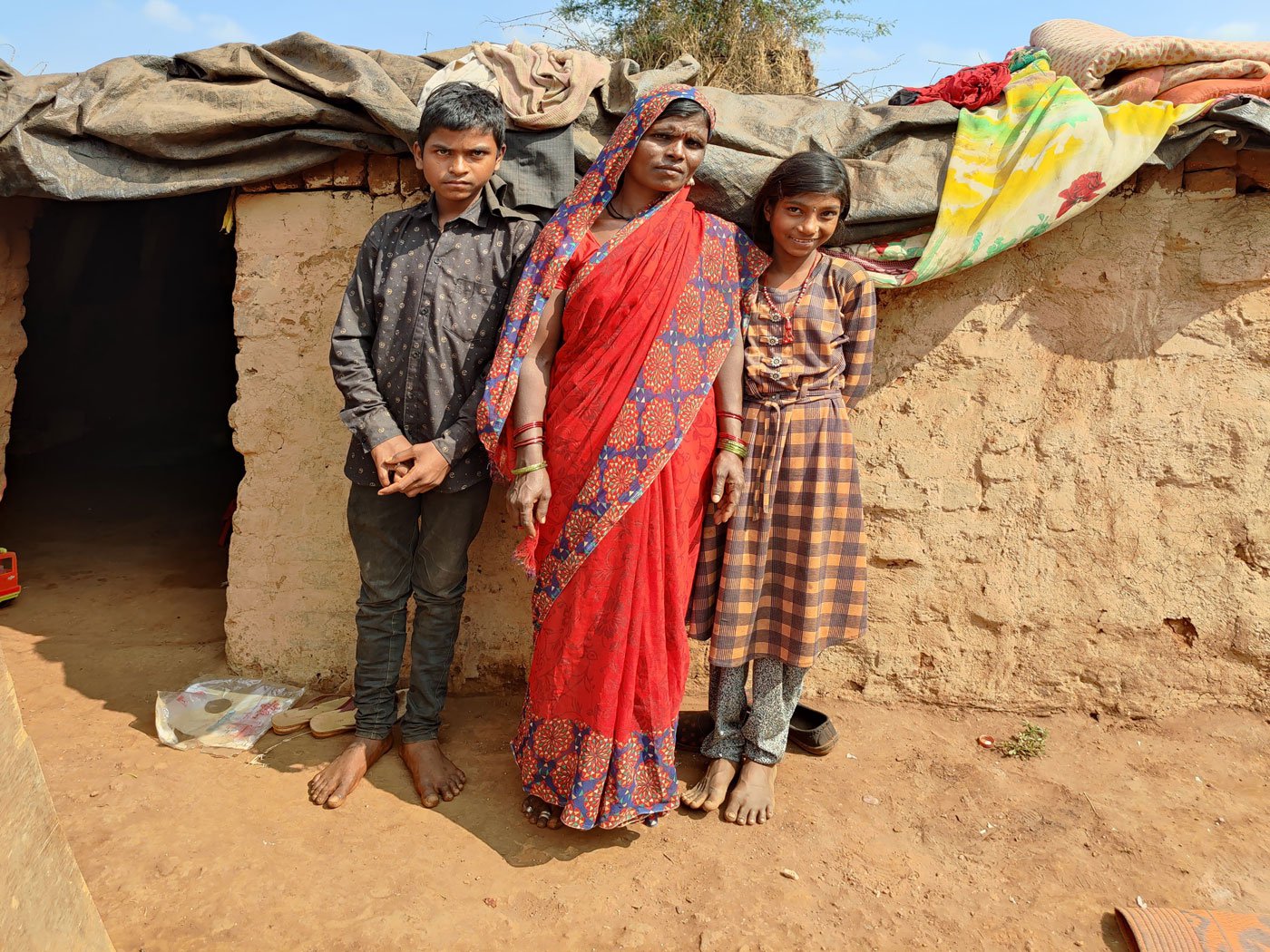
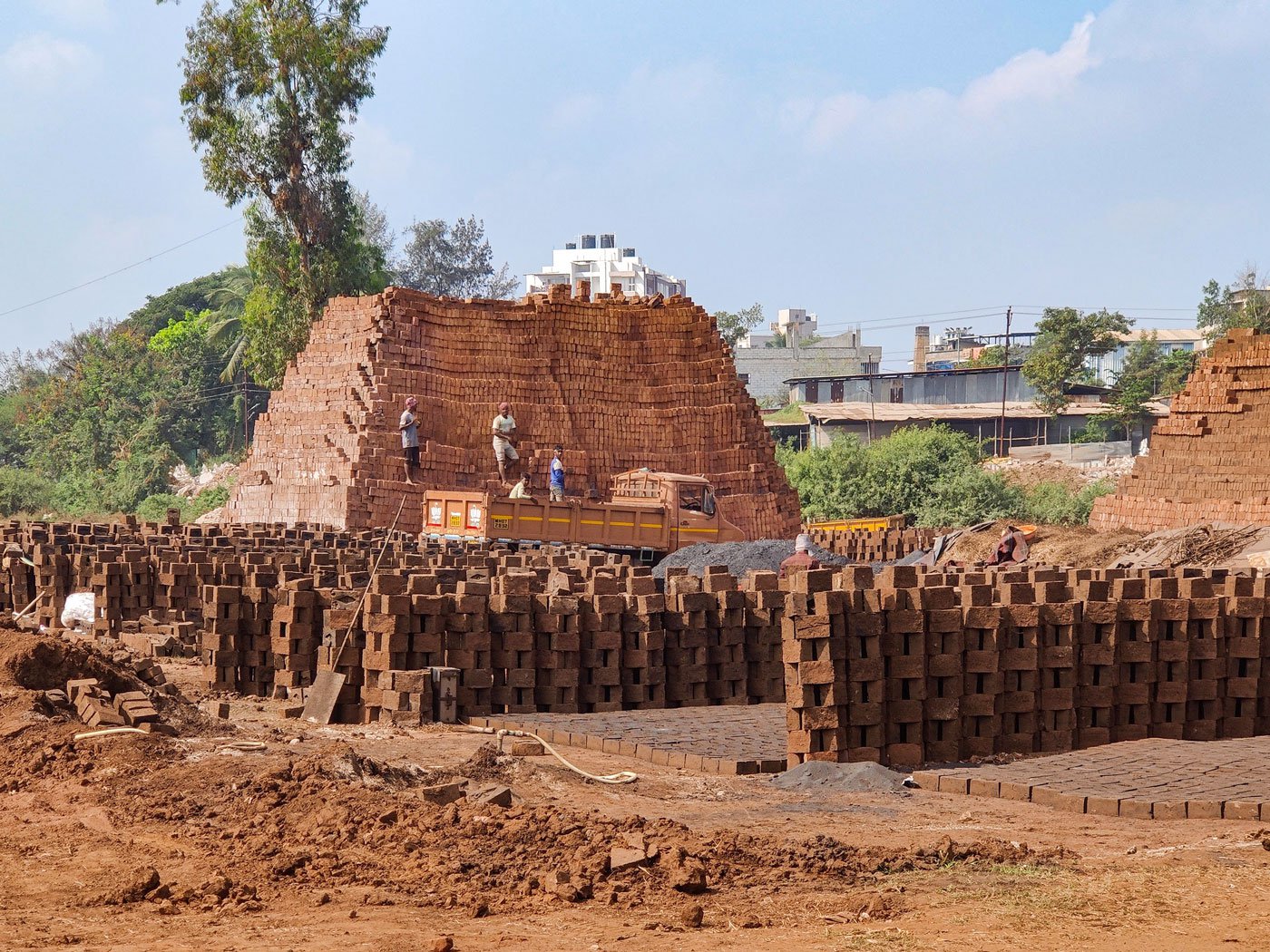
Left: Arjun, with his mother Suman and cousin Anita. Right: A brick kiln site in Jadhavwadi. The high temperatures and physically arduous tasks for exploitative wages make brick kilns the last resort of those seeking work
Back in Wadgaon, Arjun’s parents, Suman and Abasaheb work as farm labourers in and around the village in Gangapur taluka . They get work for roughly 20 days in a month during the cultivation and harvesting seasons and earn around Rs. 250-300 each for a day’s labour. During these months, Arjun can attend the school in his village.
Last year, his parents took uchal – an advance, to build a pucca house next to their thatched hut. “We took an advance of Rs. 1.5 lakhs and built the base of our house,” Suman says. “This year, we took another advance of one lakh rupees to build the walls.”
Explaining their migration she adds, “We can’t earn a lakh [rupees] in a year by any other means. This [migrating to work in brick kilns] is the only way.” And she adds that they will likely be back next year, “to arrange money for the plaster of the house.”
Two years gone in the making and another two to go – meanwhile Arjun’s education has paused. Four of Suman’s five children dropped out of school and were married before they even turned 20. Worried and unhappy about her child’s future she says, “My grandparents used to work in brick kilns; then my parents too, and now I work in brick kilns. I don’t know how to stop this cycle of migration.”
Arjun is the only one who is still studying, but he says, “After six months of missing school, I don’t feel like studying when I go back home.”
For six hours every day, Arjun and Anita (his maternal cousin) are at a day-care centre run by Avani, a non-governmental organisation that has set up at the site of the kiln. Avani runs day-care centres in over 20 brick kilns sites and a few sugarcane farm sites in Kolhapur and Sangli. Many of the students at Avani are Katkari, listed as Particularly Vulnerable Tribal Groups (PVTGs) or Beldar, listed as a Nomadic Tribe. With close to 800 registered brick kilns, Kolhapur is a major attraction for migrants who seek work, explains Sattappa Mohite, programme co-ordinator at Avani.
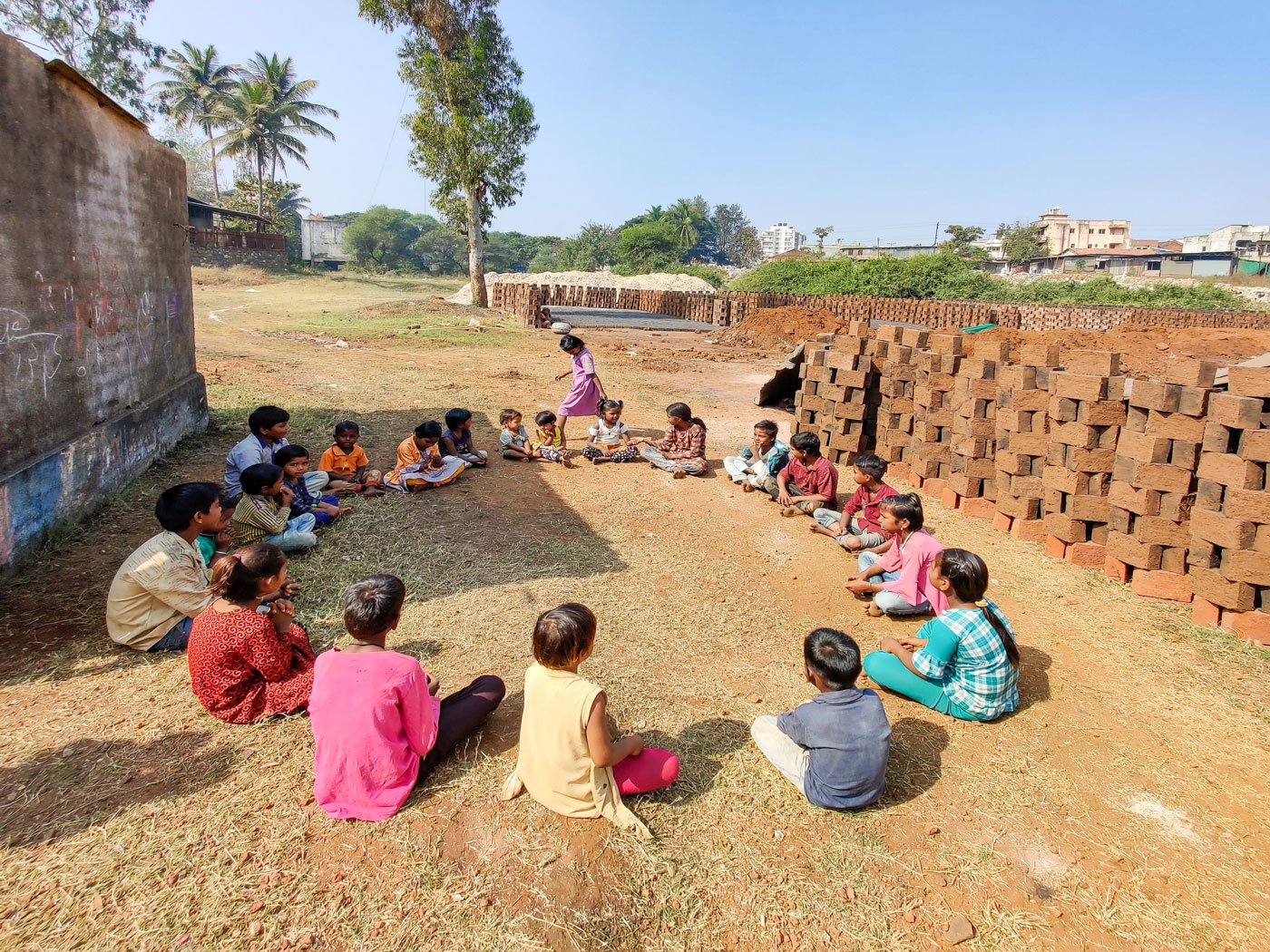
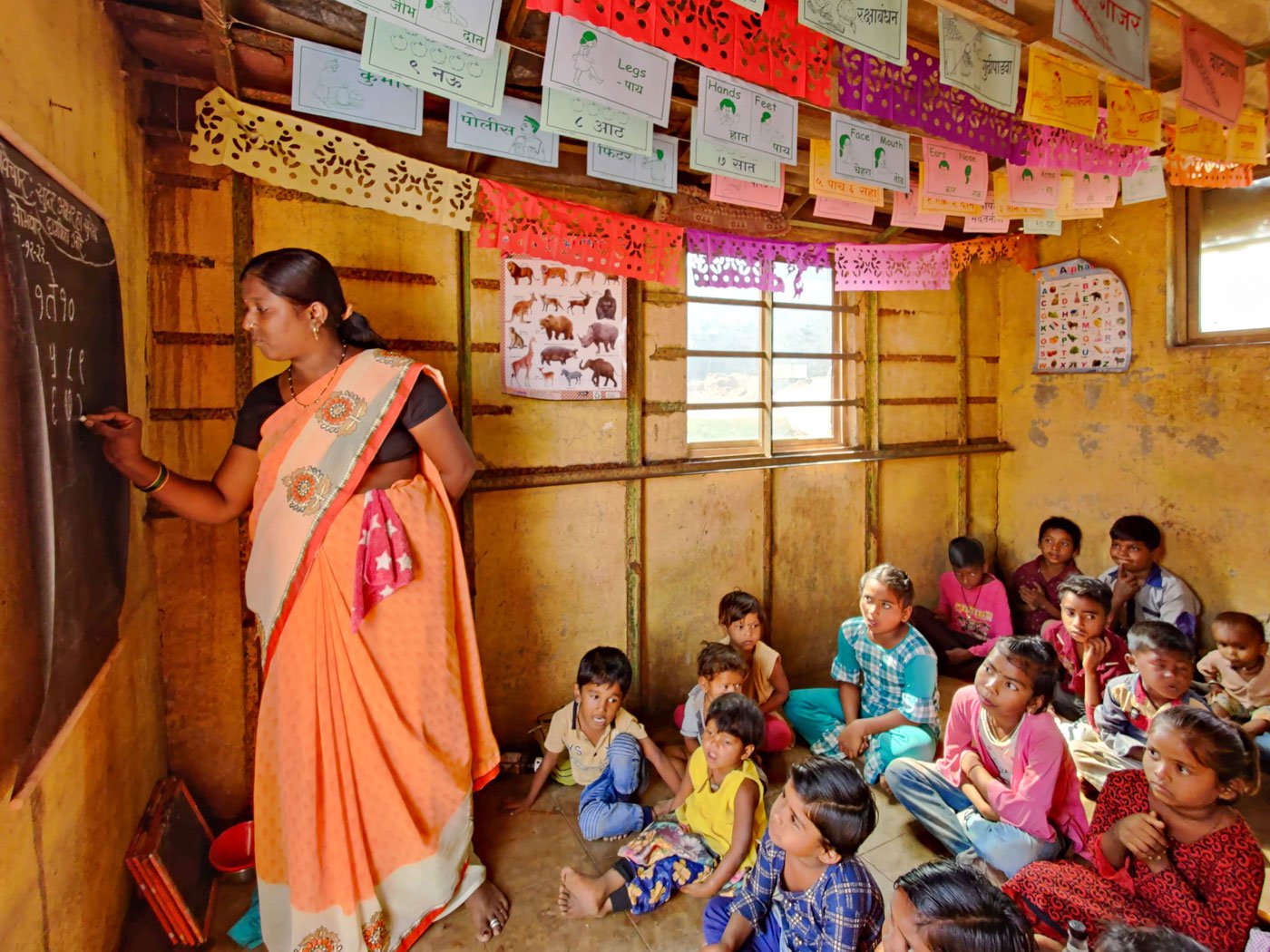
Avani's day-care school in Jadhavwadi brick kiln and (right) inside their centre where children learn and play
“Here [at the day-care centre] I don’t read books for Class 4. We get to eat and play, though,” Anita says, smiling. About 25 migrant children between the ages of 3 and 14 spend their day at the centre. In addition to a mid-day meal, children get to play games and hear stories.
When their day at the centre ends, Arjun adds hesitatingly, “we help aai-baba [in moulding bricks].”
Seven-year-old Rajeshwari Naynegeli is one of the children at the centre. She adds, “I sometimes make bricks at night with my mother.” A student of Class 2 back in her village in Karnataka, little Rajeshwari is adept at the exacting task: “ Aai and baba prepare the clay in the afternoon, and they make bricks at night. I follow what they do.” She fills clay into the brickmould and sets it by constantly patting it. Then either her mother or father unmolds it because it's too heavy for the young child to lift.
“I don't know how many [bricks] I make, but I sleep when I am tired and aai-baba keep working," says Rajeshwari.
None of the 25 children at Avani – many of whom are from within Maharashtra – possess an EGC card to continue their studies after migrating to Kolhapur. Moreover, the school closest to the kiln is five kms away.
“It [the school] is so far away. Who will take us there?” Arjun demands to know.
The card, in fact, assures parents and children that when the nearest school is more than a km away, “local education department, zilla parishad or municipal corporation should provide classrooms and transportation facilities for the education of migrant children.”
But as Anuradha Bhosale, founder and director of NGO Avani who has been working here for 20 years points out, “These provisions are only on paper.”
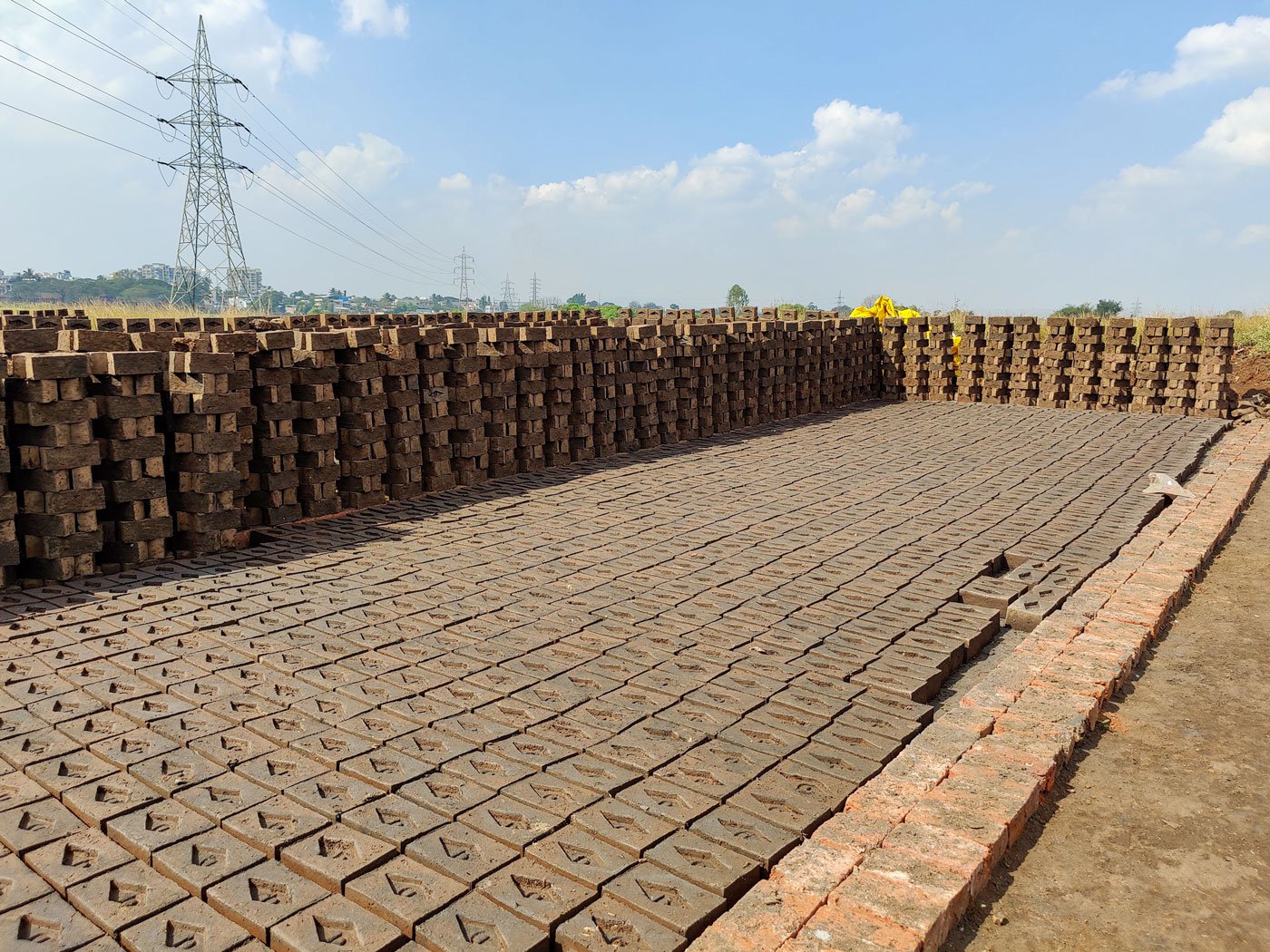
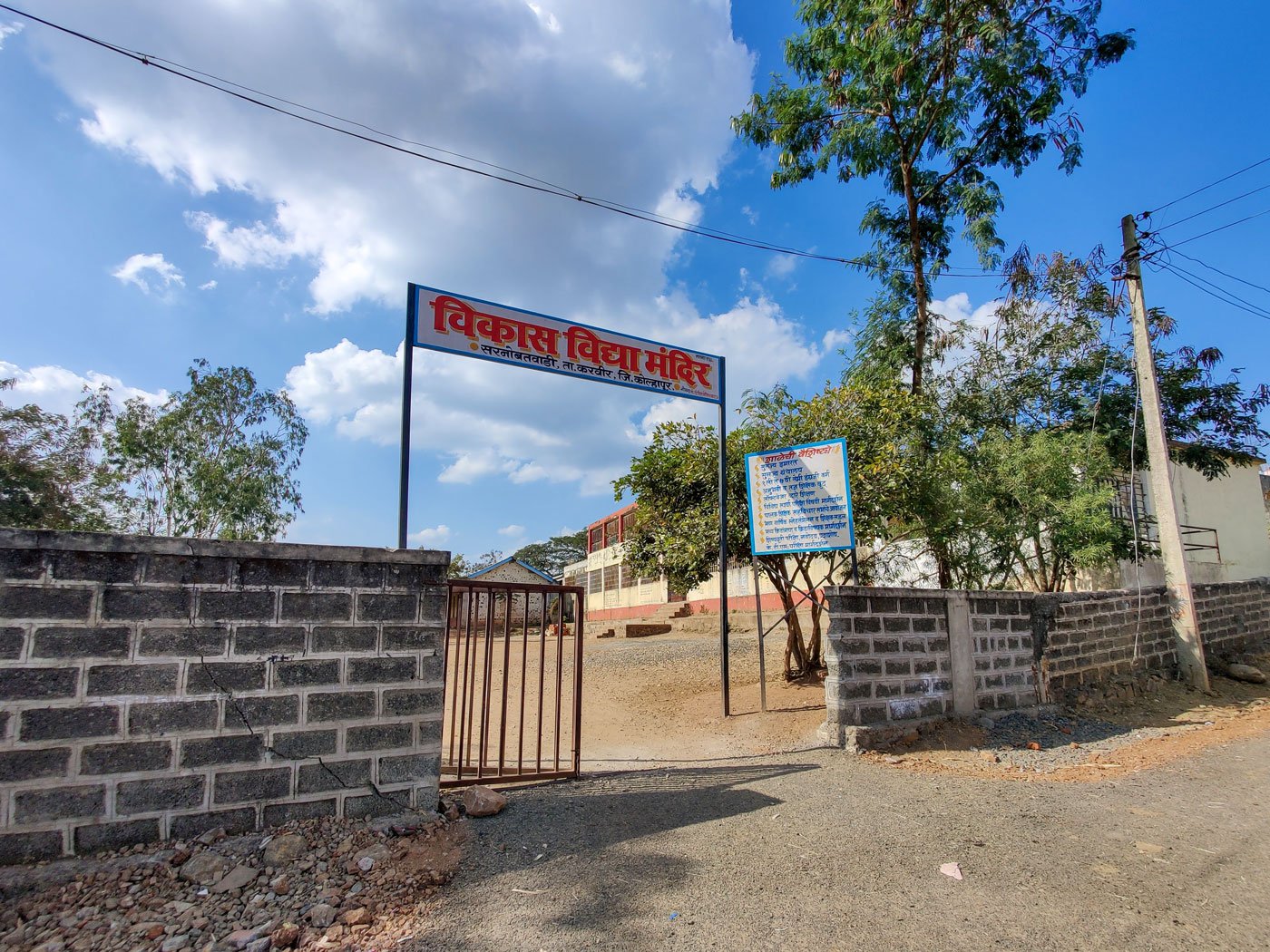
Left: Jadhavwadi Jakatnaka, a brick kiln site in Kolhapur. Right: The nearest state school is five kms from the site in Sarnobatwadi
From Ahmednagar district, Aarti Pawar works at the Kolhapur brick kiln. “My parents married me off in 2018,” says the 23-year-old who dropped out of school after Class 7.
*****
“I didn’t study anything for two years. We don’t have a smartphone,” says Arjun referring to the period March 2020-June 2021 when education moved entirely online.
“Even before the pandemic, it was difficult for me to pass since I miss school for many months. I had to repeat Class 5,” says Arjun who is now in Class 8. Like many students across Maharashtra, during the pandemic Arjun was promoted twice (Class 6 and 7) despite not attending school, as per government orders.
The number of people migrating within the country is 37 per cent (450 million) of India’s total population (Census 2011), and many of them are estimated to be children. This large number makes effective policies – and their proper implementation – an urgent necessity. Ensuring that the children of migrant workers continue their education without a break is a crucial policy action recommended by an ILO report published in 2020.
“At the state or the central level, the government is not serious in implementing policies which will guarantee education for migrating children,” says Ashok Tangde. Thus lacunae is not only depriving children of migrant workers of their right to an education, but they are also compelled to live in extremely unsafe environments.
A young Geetanjali Suna from Odisha’s Sunalarambha village in Bargarh district, travelled across the country to the Kolhapur brick-kiln with her parents and sister in November 2022. Amidst the clamouring machines, the 10-year-old Geetanjali plays a game of tag with other children at Avani and for a few brief moments, the sound of giggling children also fills the dusty air around the Kolhapur brick kiln.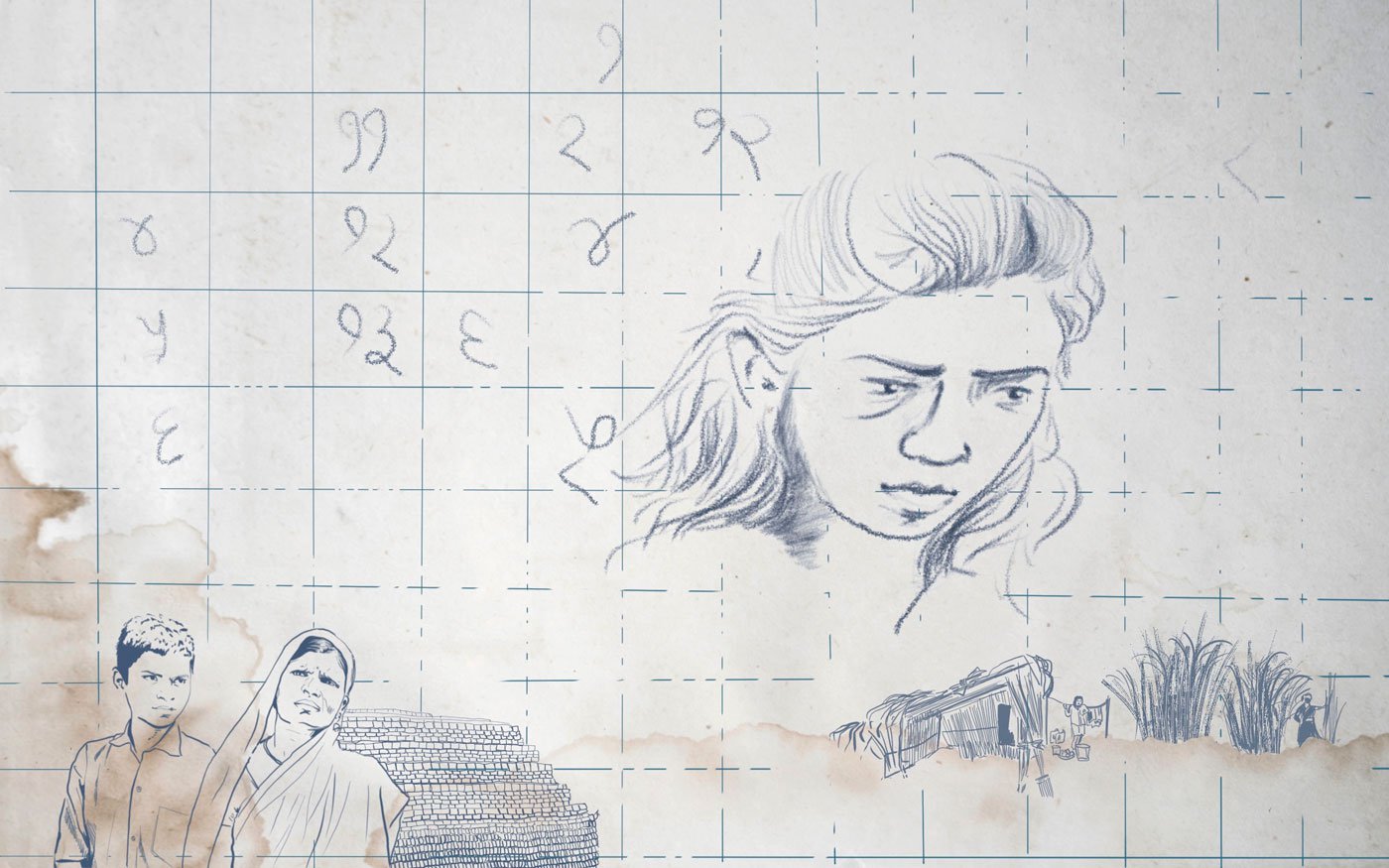
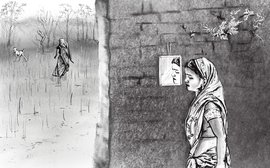
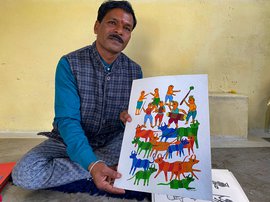
!['My kaat [uterus] keeps coming out'](/media/images/01-Prolapsed-Uterus-JS.width-270.jpg)
